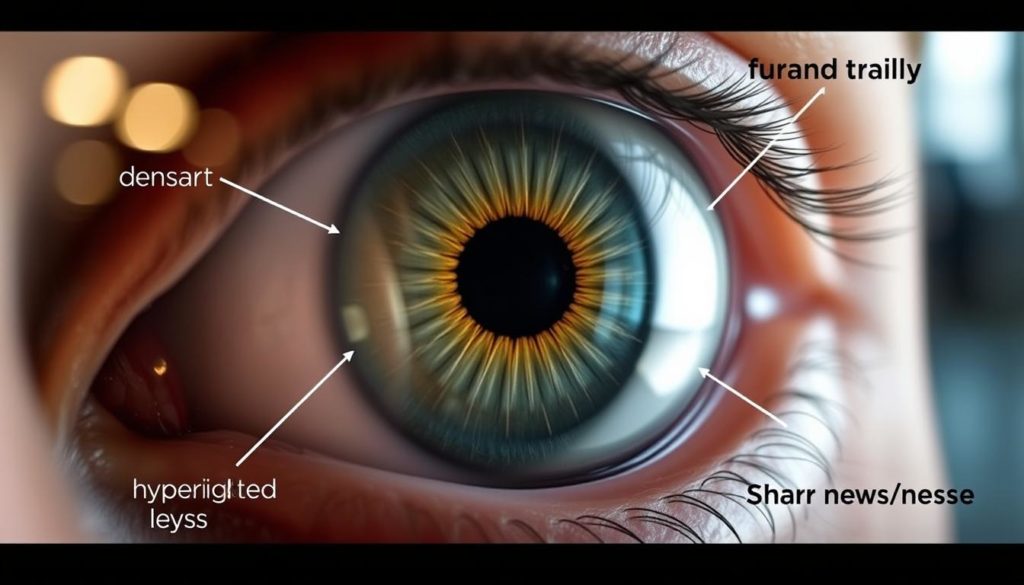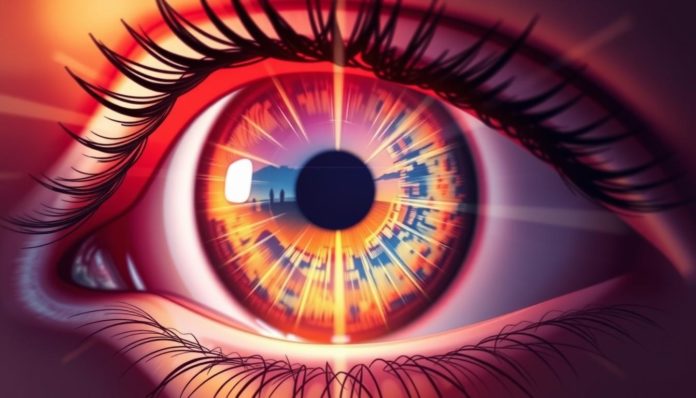Did you know that about 14.2 million Americans have hyperopia, also known as farsightedness? This common issue makes simple tasks hard, like reading or using a computer.
Farsightedness happens when light focuses behind the retina, not directly on it. This causes blurry close-up vision. Knowing the basics of farsightedness helps us understand its effects on daily life. It also shows why regular eye exams are crucial.
What is Hyperopia?
Hyperopia, also known as farsightedness, is a common vision problem. It affects millions globally. It’s about how our eyes focus on objects at different distances.
Definition of Hyperopia
Hyperopia makes it easier to see things far away than close ones. This happens because light focuses behind the retina, not directly on it. People with hyperopia find it hard to see things up close.
Difference Between Hyperopia and Myopia
Understanding hyperopia and myopia is key. Hyperopia makes it tough to see things near you. Myopia, or nearsightedness, makes it hard to see things far away. Here’s a table showing the main differences:
| Condition | Primary Symptom | Focus Point |
|---|---|---|
| Hyperopia | Difficulty seeing close-up objects | Light focused behind the retina |
| Myopia | Difficulty seeing distant objects | Light focused in front of the retina |

Common Misconceptions About Hyperopia
There are many farsightedness misconceptions. One is thinking hyperopia only affects older people, which is not true. It can happen at any age. Another myth is that it’s just a minor problem. But, not treating it can cause eye strain, headaches, and more. It’s important to clear up these myths for better understanding and treatment.
Hyperopia (Farsightedness) Overview
Hyperopia, or farsightedness, affects many people. Knowing the hyperopia causes helps us understand why it happens. It usually comes from an eyeball that’s too short or a cornea that’s too flat. This makes light focus behind the retina, causing blurry vision for close things.

Spotting hyperopia symptoms early is key. Signs include trouble reading, headaches, and eye strain. People might also feel tired from trying to focus on near things. These signs often prompt people to see an eye doctor.
Hyperopia diagnosis starts with a detailed eye exam. An optometrist or ophthalmologist will check your vision and how your eyes focus. This helps figure out how much correction you need.
There are many ways to treat hyperopia. Glasses and contact lenses are the most common fixes. For a more lasting solution, laser surgery like LASIK can reshape your cornea to better focus light.
| Causes | Symptoms | Diagnosis Methods | Treatment Options |
|---|---|---|---|
| Short eyeball | Difficulties with close-up vision | Refraction assessment | Prescription glasses |
| Flat cornea | Frequent headaches | Vision acuity test | Contact lenses |
| Hereditary factors | Eye strain and fatigue | Comprehensive eye exam | Laser eye surgery |
Causes of Farsightedness
Understanding why hyperopia happens is key to managing it. Hyperopia, or farsightedness, is caused by several factors:
Genetic Factors
Genetics are a big part of hyperopia. If your parents are farsighted, you might be too. Studies show that eye problems linked to genes play a big role in hyperopia.
Environmental Influences
Environmental factors also play a part. Too much reading or screen time can strain your eyes. This can make farsightedness worse. It’s important to take breaks and use good lighting to protect your eyes.
Age-Related Factors
Age is another factor in hyperopia. As we get older, our eyes have trouble focusing on close things. This is why many older adults become farsighted.
Looking at genetics, environment, and age helps us understand hyperopia better. We can then work on better eye health strategies.
Symptoms of Hyperopia
It’s important to know the signs of hyperopia early. This helps in getting the right treatment quickly. Spotting these signs can lead you to get help sooner.
Difficulties in Close-Up Vision
Having trouble with close-up tasks is a big sign. You might struggle with reading, using your phone, or working on a computer. This can really affect your daily life and how well you work.
Frequent Headaches
Getting headaches often, especially after doing close work, is another sign. These headaches come from trying hard to see things up close. If you get headaches a lot while reading or working on a computer, it might be hyperopia.
Eye Strain and Fatigue
Eye strain and feeling tired are common signs of hyperopia. You might feel like your eyes are working too hard. It’s key to notice these signs early to avoid eye damage.
Diagnosing Hyperopia
Getting a hyperopia diagnosis starts with a detailed eye check-up. An optometrist or ophthalmologist does this. They use many tools and methods to check the eyes’ health and find any vision problems.
The refraction assessment is a key part of this. It finds out what lenses you need to see clearly. You look through a phoropter while the doctor changes lenses to find the best one.
An accommodation check is also important. It tests how well you can focus on things up close. This is key because people with hyperopia often have trouble seeing things that are near.
The slit-lamp examination is another key part. It lets the doctor look closely at the eye’s parts. They check the cornea, iris, and lens to make sure they’re okay and to find any other problems.
Here’s a closer look at what happens in an eye exam for hyperopia:
- Visual Acuity Test
- Refraction Test
- Ocular Health Assessment
- Slit-Lamp Examination
- Pupil Dilation
Getting a correct diagnosis is the first step to better vision. It’s important to have regular eye tests. This helps keep your vision sharp and makes sure your treatment is right.
Treatment Options for Hyperopia
There are many ways to treat hyperopia, from simple glasses to advanced surgeries. Each method works differently, offering both short-term and long-term fixes.
Prescription Glasses
Prescription glasses are a popular choice for hyperopia. They help focus light on the retina, making vision clear. Many people find glasses easy to use every day.
Contact Lenses
Contact lenses are a good alternative to glasses. They sit on the eye, offering natural vision without frames. They’re great for those who are active or don’t like wearing glasses. There are many types, like daily or extended wear lenses.
Laser Eye Surgery
For a permanent fix, LASIK or PRK can reshape the cornea. These surgeries change how light bends, reducing the need for glasses. Laser eye surgery is chosen by many for its lasting results and success.
| Treatment Method | Benefits | Considerations |
|---|---|---|
| Prescription Glasses | Cost-effective, easy to use | Requires regular updates, may be inconvenient for some activities |
| Contact Lenses | Discreet, clear peripheral vision | Requires daily maintenance, potential for eye irritation |
| Laser Eye Surgery | Permanent correction, high success rates | Higher cost, surgical risks and recovery time |
Preventing Hyperopia
Keeping your eyes healthy is key to preventing hyperopia. While genes can influence it, there are steps you can take. These steps can slow down or lessen the effects of farsightedness. Here are some important practices to follow:
1. Regular Eye Check-Ups: Seeing an eye doctor regularly is crucial. It helps catch hyperopia early. Early detection means better treatment and less chance of it getting worse.
2. Protective Measures: Wearing sunglasses with UV protection is a simple yet effective step. It shields your eyes from harmful UV rays. This helps keep your eyes healthy.
3. Balanced Diet: Eating foods rich in vitamins A, C, and E, and omega-3 fatty acids is good for your eyes. These nutrients support healthy vision.
4. Limit Screen Time: Spending less time in front of screens can prevent eye strain. The 20-20-20 rule is helpful: every 20 minutes, look at something 20 feet away for 20 seconds. This reduces eye fatigue.
| Protective Measure | Description |
|---|---|
| Regular Eye Check-Ups | Early detection and management of hyperopia. |
| Protective Eyewear | UV protection to safeguard eyes from harmful rays. |
| Balanced Diet | Rich in essential vitamins and nutrients. |
| Limit Screen Time | Prevent eye strain and fatigue with the 20-20-20 rule. |
By following these steps, you can keep your eyes healthy. This may reduce the risk or impact of hyperopia over time.
Risk Factors Associated with Hyperopia
Knowing the main risk factors for hyperopia helps protect your eyes. Consider genetic predisposition, age, and lifestyle choices.
Family History
A family history of hyperopia is a big risk factor. Hereditary eye conditions often play a big role. If your parents or siblings have it, you’re more likely to get it too.
Age Considerations
As we age, our vision changes. Our eyes lose flexibility, making it hard to focus on close objects. This is why aging eyes are more likely to have hyperopia. It’s common in older adults but can happen at any age, so regular eye exams are key.
Lifestyle Choices
Your lifestyle affects your risk of hyperopia. Prolonged screen time, poor lighting, and not enough outdoor activities can strain your eyes. Healthy habits can help reduce these risks and improve your eye health.
Potential Complications Due to Hyperopia
Hyperopia, or farsightedness, can cause serious hyperopia complications if not treated. These problems go beyond just seeing things far away. They can really affect your life and how well you feel.
Not treating hyperopia can lead to vision impairment. This makes it hard to see things up close. It can also cause eye strain, headaches, and tiredness. These symptoms can make it hard to get things done during the day.
Long-term hyperopia can lead to serious ocular health issues. Kids might get strabismus (crossed eyes) or amblyopia (lazy eye). Adults could face a higher risk of glaucoma. It’s important to watch for these problems to keep your eyes healthy.
The table below shows the possible hyperopia complications and how they affect daily life:
| Complication | Impact on Vision | Overall Well-being |
|---|---|---|
| Eye Strain | Reduces close-up vision clarity | Causes headaches, fatigue |
| Strabismus | Misalignment of eyes | Affects depth perception |
| Amblyopia | Blurry vision in one eye | Decreases overall visual ability |
| Glaucoma | Increased eye pressure | Potential vision loss |
Knowing about these ocular health issues helps you manage hyperopia better. Early treatment of vision impairment can stop worse hyperopia complications. This way, you can live a better life.
Hyperopia Statistics in the United States
Hyperopia, or farsightedness, affects many people in the United States. It’s important to understand its impact on eye health. Data shows that about 5-10% of Americans have hyperopia, with more cases as people get older.
| Age Group | Prevalence Rate |
|---|---|
| Children (0-14 years) | 5% |
| Adults (15-49 years) | 6% |
| Seniors (50+ years) | 10% |
These numbers highlight the need for eye care, especially for older adults. Regular eye exams and proper treatment are key to managing hyperopia. This helps improve daily life and overall health.
Embracing a Clearer Future: Living with Hyperopia
At first, living with hyperopia might seem tough. But learning to adapt to farsightedness is key to good eye health. You can choose the right glasses and adopt healthy habits to face farsightedness challenges.
Choosing the right eyewear is a big step in managing hyperopia. Glasses and contact lenses can greatly improve your vision. It’s important to see an eye doctor regularly to update your prescription and ensure your lenses work well. Also, multifocal lenses can help with both near and far vision.
Healthy habits are also crucial for eye health. Eating foods rich in vitamins A, C, and E, and omega-3 fatty acids helps your eyes. Exercise and avoiding too much screen time and UV exposure also help.
Using technology like blue light glasses and apps can reduce eye strain. A good approach to hyperopia includes both quick fixes and long-term habits. By being informed and proactive, you can look forward to a clearer future.
FAQ
What is hyperopia?
Hyperopia, also known as farsightedness, makes it easier to see distant objects than close ones. This happens when light focuses behind the retina instead of right on it.
What are the main symptoms of hyperopia?
Symptoms include trouble focusing on things up close, headaches, and eye strain from reading or computer use.
How is hyperopia diagnosed?
An eye doctor checks for hyperopia with a vision test and refraction assessment. These tests show how far-sighted you are.
What causes hyperopia?
It can be due to genes, environment, or age changes in the eye. Often, it’s because the eyeball is too short or the cornea is too flat.
How can hyperopia be treated?
Treatments include glasses, contact lenses, and laser surgery. These options help light focus better on the retina, improving near vision.
Can hyperopia be prevented?
While you can’t always prevent it, regular eye exams and good eye health can help manage it. This can slow down its progression.
What are the main risk factors associated with hyperopia?
Risk factors include family history, aging, and lifestyle choices. For example, too much screen time can strain your eyes.
What complications can arise from untreated hyperopia?
Untreated hyperopia can cause eye strain and headaches. It can also affect daily life and lead to serious vision problems, especially in children.
What are some statistics on hyperopia in the United States?
Hyperopia affects millions in the U.S. Many children and adults have some degree of farsightedness.
How can one live comfortably with hyperopia?
To manage hyperopia, choose the right glasses or contacts. Practice good eye care and get regular eye exams. These steps help keep your vision clear and comfortable.


